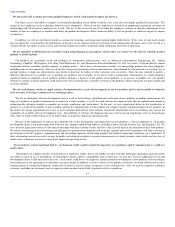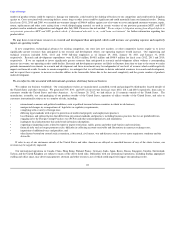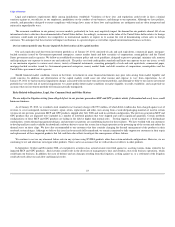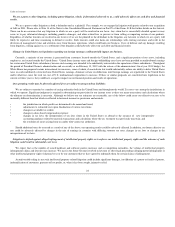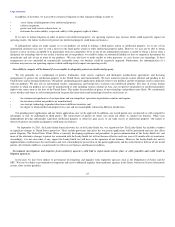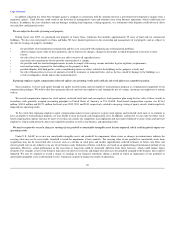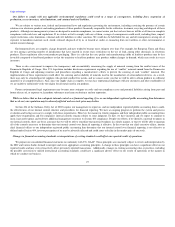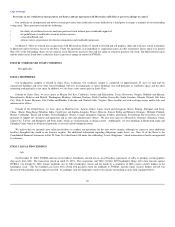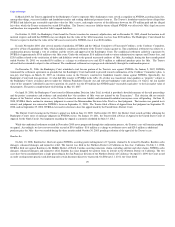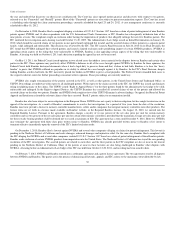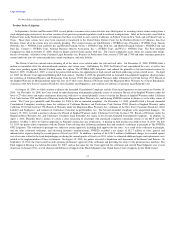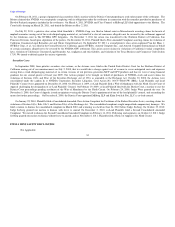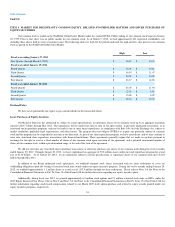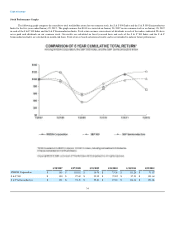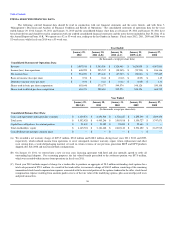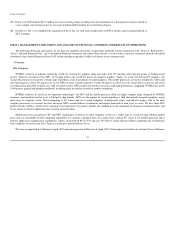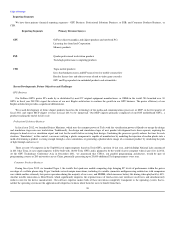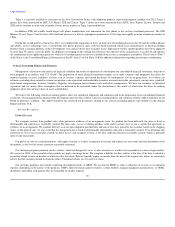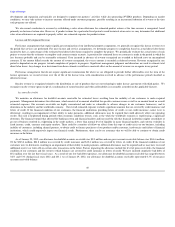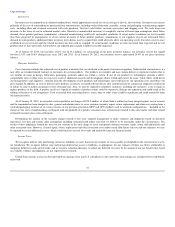NVIDIA 2012 Annual Report Download - page 32
Download and view the complete annual report
Please find page 32 of the 2012 NVIDIA annual report below. You can navigate through the pages in the report by either clicking on the pages listed below, or by using the keyword search tool below to find specific information within the annual report.
Table of Contents
Product Defect Litigation and Securities Cases
Product Defect Litigation
In September, October and November 2008, several putative consumer class action lawsuits were filed against us, asserting various claims arising from a
weak die/packaging material set in certain versions of our previous generation products used in notebook configurations. Most of the lawsuits were filed in
Federal Court in the Northern District of California, but three were filed in state court in California, in Federal Court in New York, and in Federal Court in
Texas. Those three actions have since been removed or transferred to the United States District Court for the Northern District of California, San Jose
Division, where all of the actions now are currently pending. The various lawsuits are titled Nakash v. NVIDIA Corp., Feinstein v. NVIDIA Corp., Inicom
Networks, Inc. v. NVIDIA Corp. and Dell, Inc. and Hewlett Packard, Olivos v. NVIDIA Corp., Dell, Inc. and Hewlett Packard, Sielicki v. NVIDIA Corp. and
Dell, Inc., Cormier v. NVIDIA Corp., National Business Officers Association, Inc. v. NVIDIA Corp., and West v. NVIDIA Corp. The First Amended
Complaint was filed on October 27, 2008, which no longer asserted claims against Dell, Inc. The various complaints assert claims for, among other things,
breach of warranty, violations of the Consumer Legal Remedies Act, Business & Professions Code sections 17200 and 17500 and other consumer protection
statutes under the laws of various jurisdictions, unjust enrichment, and strict liability.
The District Court has entered orders deeming all of the above cases related under the relevant local rules. On December 11, 2008, NVIDIA filed a
motion to consolidate all of the aforementioned consumer class action cases. On February 26, 2009, the District Court consolidated the cases, as well as two
other cases pending against Hewlett Packard, under the caption “The NVIDIA GPU Litigation” and ordered the plaintiffs to file lead counsel motions by
March 2, 2009. On March 2, 2009, several of the parties filed motions for appointment of lead counsel and briefs addressing certain related issues. On April
10, 2009, the District Court appointed Milberg LLP lead counsel. On May 6, 2009, the plaintiffs filed an Amended Consolidated Complaint, alleging claims
for violations of California Business and Professions Code Section 17200, Breach of Implied Warranty under California Civil Code Section 1792, Breach of
the Implied Warranty of Merchantability under the laws of 27 other states, Breach of Warranty under the Magnuson-Moss Warranty Act, Unjust Enrichment,
violations of the New Jersey Consumer Fraud Act, Strict Liability and Negligence, and violation of California's Consumer Legal Remedies Act.
On August 19, 2009, we filed a motion to dismiss the Amended Consolidated Complaint, and the Court heard arguments on that motion on October 19,
2009. On November 19, 2009, the Court issued an order dismissing with prejudice plaintiffs causes of action for Breach of the Implied Warranty under the
laws of 27 other states and unjust enrichment, dismissing with leave to amend plaintiffs' causes of action for Breach of Implied Warranty under California
Civil Code Section 1792 and Breach of Warranty under the Magnuson-Moss Warranty Act, and denying NVIDIA's motion to dismiss as to the other causes of
action. The Court gave plaintiffs until December 14, 2009 to file an amended complaint. On December 14, 2009, plaintiffs filed a Second Amended
Consolidated Complaint, asserting claims for violations of California Business and Professions Code Section 17200, Breach of Implied Warranty under
California Civil Code Section 1792, Breach of Warranty under the Magnuson-Moss Warranty Act, violations of the New Jersey Consumer Fraud Act, Strict
Liability and Negligence, and violation of California's Consumer Legal Remedies Act. The Second Amended Complaint seeks unspecified damages. On
January 19, 2010, we filed a motion to dismiss the Breach of Implied Warranty under California Civil Code Section 1792, Breach of Warranty under the
Magnuson-Moss Warranty Act, and California's Consumer Legal Remedies Act claims in the Second Amended Consolidated Complaint. In addition, on
April 1, 2010, Plaintiffs filed a motion to certify a class consisting of all people who purchased computers containing certain of our MCP and GPU
products. On May 3, 2010, we filed an opposition to Plaintiffs' motion for class certification. A hearing on both motions was held on June 14, 2010. On July
16, 2010, the parties filed a stipulation with the District Court advising that, following mediation they had reached a settlement in principle in The NVIDIA
GPU Litigation. The settlement in principle was subject to certain approvals, including final approval by the court. As a result of the settlement in principle,
and the other estimated settlement, and offsetting insurance reimbursements, NVIDIA recorded a net charge of $12.7 million to sales, general and
administrative expense during the second quarter of fiscal year 2011. In addition, a portion of the $181.2 million of additional charges we recorded against
cost of revenue related to the weak die/packaging set during the second quarter of fiscal year 2011, relates to estimated additional repair and replacement costs
related to the implementation of these settlements. On August 12, 2010, the parties executed a Stipulation and Agreement of Settlement and Release. On
September 15, 2010, the Court issued an order granting preliminary approval of the settlement and providing for notice to the potential class members. The
Final Approval Hearing was held on December 20, 2010, and on that same day the Court approved the settlement and entered Final Judgment over several
objections. In January 2011, several objectors filed Notices of Appeal of the Final Judgment to the United States Court of Appeals for the Ninth Circuit.
31


